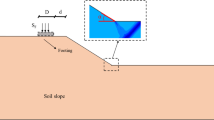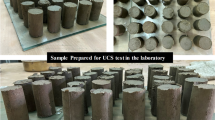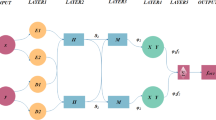Abstract
The undrained shear strength (USS) of soil is known as one of the most important features in structural engineering tasks, such as foundation design, rock fill and earth dam design, highway and railway design, and stability of slopes. Some empirical and theoretical procedures have been developed for estimating the USS based on soil features utilizing field tests in recent years. Almost all of these methods contain correlation assumptions which lead to inaccurate results. In addition, conventional procedures are rarely time and cost-effective. In this paper, to put down these deficiencies, novel machine learning approaches are based on the Adaptive Neural Fuzzy Inference System (ANFIS) model for predicting the Undrained shear strength of sensitive soils. Furthermore, for optimizing purposes, three meta-heuristic optimization strategies comprising Equilibrium Slime Mould Algorithm (ESOMA), School Based Optimization (SBO), and Slime Mould Algorithm (SMA) were applied. Models were trained with four input variables named liquid limit (LL), sleeve friction (SF), overburden weight (OBW), and plastic limit (PL). At the final stage, five statistical metrics (R2, RMSE, MDAE, MSE, and n20_index) were considered for evaluating the models. As a result, ANFEA obtained the highest \({R}^{2}=0.995\) and the lowest \(\text{RMSE}=62.95 (\text{Kpa})\) compared to other hybrid models.





Similar content being viewed by others
References
Abu-Farsakh MY, Mojumder MAH (2020) Exploring artificial neural network to evaluate the undrained shear strength of soil from cone penetration test data. Transp Res Rec 2674(4):11–22
Afzal S, Ziapour BM, Shokri A, Shakibi H, Sobhani B (2023) Building energy consumption prediction using multi-layer perceptron neural network-assisted models; comparison of different optimization algorithms. Energy. https://doi.org/10.1016/j.energy.2023.128446
Akan R, Keskin SN (2019) The effect of data size of ANFIS and MLR models on prediction of unconfined compression strength of clayey soils. SN Appl Sci 1(8):843
Akan R, Keskin SN, Uzundurukan S (2015) Multiple regression model for the prediction of unconfined compressive strength of jet grout columns. Procedia Earth Planet Sci 15:299–303
Al-Hamed S, Wahby M, Al-Sulaiman M, Aboukarima A (2014) Prediction of soil fractions (sand, silt and clay) in surface layer based on natural radionuclides concentration in the soil using adaptive neuro fuzzy inference system. Open J Soil Sci 4(07):215
Becker M (2015) On the efficiency of nature-inspired algorithms for generation of fault-tolerant graphs. In: 2015 IEEE international conference on systems, man, and cybernetics, pp. 1657–1663
Bisht DCS, Jangid A (2011) Discharge modelling using adaptive neuro-fuzzy inference system. Int J Adv Sci Technol 31(1):99–114
Cabalar AF, Cevik A, Gokceoglu C, Baykal G (2010) Neuro-fuzzy based constitutive modeling of undrained response of Leighton Buzzard Sand mixtures. Expert Syst Appl 37(1):842–851
Camp CV, Bichon BJ, Stovall SP (2005) Design of steel frames using ant colony optimization. J Struct Eng 131(3):369–379
Cevik A, Ozturk S (2009) Neuro-fuzzy model for shear strength of reinforced concrete beams without web reinforcement. Civ Eng Environ Syst 26(3):263–277
Chandler RJ (1988) The in-situ measurement of the undrained shear strength of clays using the field vane. ASTM International, West Conshohocken
Das SK, Basudhar PK (2006) Undrained lateral load capacity of piles in clay using artificial neural network. Comput Geotech 33(8):454–459
Di Buò B, Selänpää J, Länsivaara TT, D’Ignazio M (2019) Evaluation of sample quality from different sampling methods in Finnish soft sensitive clays. Can Geotech J 56(8):1154–1168
Faramarzi A, Heidarinejad M, Stephens B, Mirjalili S (2020) Equilibrium optimizer: a novel optimization algorithm. Knowledge-Based Syst 191:105190. https://doi.org/10.1016/j.knosys.2019.105190
Farshchin M, Camp CV, Maniat M (2016a) Multi-class teaching-learning-based optimization for truss design with frequency constraints. Eng Struct 106:355–369
Farshchin M, Camp CV, Maniat M (2016b) Optimal design of truss structures for size and shape with frequency constraints using a collaborative optimization strategy. Expert Syst Appl 66:203–218
Hansbo S (1957) New approach to the determination of the shear strength of clay by the fall-cone test. Statens geotekniska institut
Howard FL (1931) The life history of Physarum polycephalum. Am J Bot 18:116–133
Ikizler SB, Aytekin M, Vekli M, Kocabaş F (2010) Prediction of swelling pressures of expansive soils using artificial neural networks. Adv Eng Softw 41(4):647–655
Jang J-S (1993) ANFIS: adaptive-network-based fuzzy inference system. IEEE Trans Syst Man Cybern 23(3):665–685
Jang J-SR, Sun C-T, Mizutani E (1997) Neuro-fuzzy and soft computing-a computational approach to learning and machine intelligence [Book Review]. IEEE Trans Automat Contr 42(10):1482–1484
Kanungo DP, Sharma S, Pain A (2014) Artificial Neural Network (ANN) and Regression Tree (CART) applications for the indirect estimation of unsaturated soil shear strength parameters. Front Earth Sci 8:439–456
Kessler D (1982) Plasmodial structure and motility. Cell Biol. Physarum Didymium/edited by Henry C. Aldrich, John W. Daniel
Kim M, Okuyucu O, Ordu E, Ordu S, Arslan Ö, Ko J (2022) Prediction of undrained shear strength by the GMDH-type neural network using SPT-value and soil physical properties. Materials (basel) 15(18):6385
Kuo YL, Jaksa MB, Lyamin AV, Kaggwa WS (2009) ANN-based model for predicting the bearing capacity of strip footing on multi-layered cohesive soil. Comput Geotech 36(3):503–516
Larsson R (1980) Undrained shear strength in stability calculation of embankments and foundations on soft clays. Can Geotech J 17(4):591–602
Li S, Chen H, Wang M, Heidari AA, Mirjalili S (2020) Slime mould algorithm: a new method for stochastic optimization. Futur Gener Comput Syst 111:300–323
Ly H-B, Pham BT (2020) Prediction of shear strength of soil using direct shear test and support vector machine model. Open Constr Build Technol J 14(1):41–50
Masoumi F, Najjar-Ghabel S, Safarzadeh A, Sadaghat B (2020) Automatic calibration of the groundwater simulation model with high parameter dimensionality using sequential uncertainty fitting approach. Water Supply 20(8):3487–3501. https://doi.org/10.2166/ws.2020.241
Mbarak WK, Cinicioglu EN, Cinicioglu O (2020) SPT based determination of undrained shear strength: Regression models and machine learning. Front Struct Civ Eng 14:185–198
Mehdi Yaltaghian Khiabani SN, Sedaghat B, Ghorbanzadeh P, Porroustami N, Mehdy Hashemy Shahdany S, Hassani Y (2023) Application of a hybrid hydro-economic model to allocate water over the micro- and macro-scale region for enhancing socioeconomic criteria under the water shortage Period. Water Econ Policy
Nejad FP, Jaksa MB (2017) Load-settlement behavior modeling of single piles using artificial neural networks and CPT data. Comput Geotech 89:9–21
Padmini D, Ilamparuthi K, Sudheer KP (2008) Ultimate bearing capacity prediction of shallow foundations on cohesionless soils using neurofuzzy models. Comput Geotech 35(1):33–46
Poorjafar A, Esmaeili-Falak M, Katebi H (2021) Pile-soil interaction determined by laterally loaded fixed head pile group. Geomech Eng 26(1):13–25. https://doi.org/10.12989/gae.2021.26.1.013
Prasad KN, Triveni S, Schanz T, Nagaraj LTS (2007) Sample disturbance in soft and sensitive clays: analysis and assessment. Mar Georesources Geotechnol 25(3–4):181–197
Rao RV, Savsani VJ, Vakharia DP (2011) Teaching–learning-based optimization: a novel method for constrained mechanical design optimization problems. Comput Des 43(3):303–315
Recep A (2022) Estimation of the maximum bending moment of cantilever sheet pile walls by using multiple linear regression analysis. Mühendislik Bilim Ve Tasarım Derg 10(1):247–256
Samui P (2008) Prediction of friction capacity of driven piles in clay using the support vector machine. Can Geotech J 45(2):288–295
Samui P, Kurup P (2012) Multivariate adaptive regression spline and least square support vector machine for prediction of undrained shear strength of clay. Int J Appl Metaheuristic Comput 3(2):33–42
Šešum-Čavić V, Kühn E, Kanev D (2016) Bio-inspired search algorithms for unstructured P2P overlay networks. Swarm Evol Comput 29:73–93
Shahin MA, Jaksa MB, Maier HR (2001) Artificial neural network applications in geotechnical engineering. Aust Geomech 36(1):49–62
Tien Bui D, Hoang N-D, Nhu V-H (2019) A swarm intelligence-based machine learning approach for predicting soil shear strength for road construction: a case study at Trung Luong National Expressway Project (Vietnam). Eng Comput 35(3):955–965
Tran Q-A, Sołowski W (2019) Generalized Interpolation Material Point Method modelling of large deformation problems including strain-rate effects—application to penetration and progressive failure problems. Comput Geotech 106:249–265
Tran Q-A, Solowski W, Karstunen M, Korkiala-Tanttu L (2017) Modelling of fall-cone tests with strain-rate effects. Procedia Eng 175:293–301
Yu K, Haeusler M, Fabbri A, Simon K (2018) Bicycle pathway generation through a weighted digital slime mold algorithm via topographical analysis. In: Proceedings of the 23rd international conference of the association for computer-aided architectural design research in Asia (CAADRIA 2018), pp. 381–390
Yuan J, Zhao M, Esmaeili-Falak M (2022) A comparative study on predicting the rapid chloride permeability of self-compacting concrete using meta-heuristic algorithm and artificial intelligence techniques. Struct Concr 23(2):753–774. https://doi.org/10.1002/suco.202100682
Zhang W, Wu C, Zhong H, Li Y, Wang L (2021) Prediction of undrained shear strength using extreme gradient boosting and random forest based on Bayesian optimization. Geosci Front 12(1):469–477
Zumrawi MME (2012) Prediction of CBR value from index properties of cohesive soils. Univ Khartoum Eng J 2(ENGINEERING)
Author information
Authors and Affiliations
Contributions
XD: Writing—original draft preparation, conceptualization, supervision, project administration.
Corresponding author
Ethics declarations
Conflict of interest
The authors declare no competing interests.
Additional information
Publisher's Note
Springer Nature remains neutral with regard to jurisdictional claims in published maps and institutional affiliations.
Rights and permissions
Springer Nature or its licensor (e.g. a society or other partner) holds exclusive rights to this article under a publishing agreement with the author(s) or other rightsholder(s); author self-archiving of the accepted manuscript version of this article is solely governed by the terms of such publishing agreement and applicable law.
About this article
Cite this article
Ding, X. Employing adaptive neural fuzzy inference system model via meta-heuristic algorithms for predicting undrained shear strength. Multiscale and Multidiscip. Model. Exp. and Des. (2023). https://doi.org/10.1007/s41939-023-00231-3
Received:
Accepted:
Published:
DOI: https://doi.org/10.1007/s41939-023-00231-3




